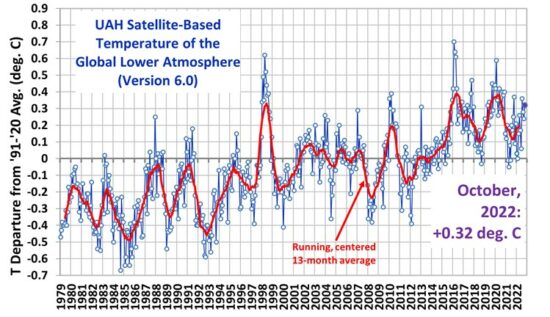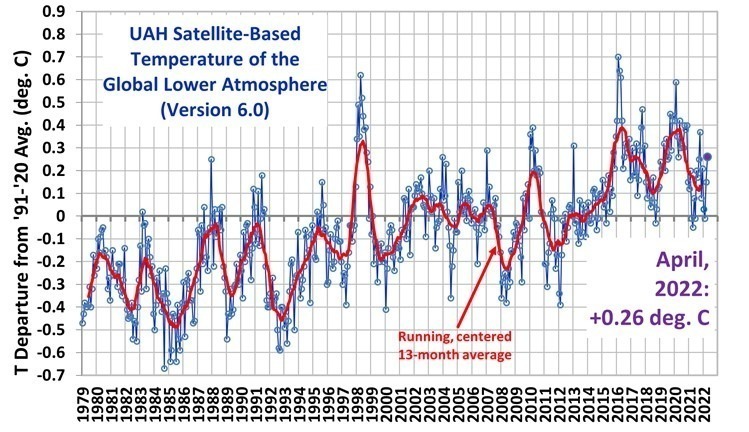
View of the crescent moon through the top of the earth's atmosphere. Photographed above 21.5°N, 113.3°E. by International Space Station crew Expedition 13 over the South China Sea, just south of Macau (NASA image ID: ISS013-E-54329). Français : Photo des couches hautes de l'atmosphère terrestre. Polski: Zdjęcie górnych warstw atmosfery ziemskiej z widocznym przejściem w przestrzeń kosmiczną. Ελληνικά: Η Γήινη ατμόσφαιρα, η φωτογραφία ελήφθη από το διάστημα κι ύψος 335 χιλιόμετρα (Photo credit: Wikipedia)
This is basically a reblogging of JoNova’s post of the same title. Or at least a part of it.
Clouds have always been a significant factor in the planetary temperature “equation”. They are either ignored by AGW science or used to their advantage to explain how the miniscule effect of CO2 can be amplified into significance.
To an observer on the earth’s surface, it is obvious that clouds block sunlight sufficiently to reduce the heating effect, reducing temperature. Less obvious but demonstrably, clouds at night trap surface heat, increasing temperature. Higher heating of surface water causes higher evaporation, in turn creating more clouds. Increased surface heating also increases atmospheric water vapour which, unless dense enough to form clouds, actually has a warming greenhouse effect.
This is very basic but significant. What cannot be quantified with any degree of accuracy is the overall influence of clouds on average global temperature (whatever computation is adopted). However, Jo’s post presents a scientific approach which reasonably argues that the net general effect of clouds is to counteract any heating influence from atmospheric ‘greenhouse gas’ parameters.
Yet the AGW scientists manage to generally ignore this significant influence.
Joint Post by Tony Cox and Jo Nova
Clouds cool the planet as it warms
Clouds cover an enormous 65% of the planet and are responsible for about half of the sunlight that is reflected back out to space.[i] The effects of clouds are so strong that most of the differences between IPCC-favoured-models comes from the assumptions the models make about clouds. Cloud feedbacks are the “largest source of uncertainty”.[ii] Numerous studies show models project wildly different results for clouds, and yet few could correctly simulate clouds as recorded by satellites.[iii] One researcher described our understanding of cloud parameters as being “still in a fairly primitive state.”[iv]
Sunlight that travels 150 million kilometers can be blocked a mere 1km away from the Earth’s surface and reflected back to space. The situation is complicated though, because clouds also slow the outgoing radiation — which has a warming effect. In general lower clouds are thicker and have a large cooling effect, while higher clouds are thinner and tend to trap more heat than they reflect (i.e. net warming). Observations show the cooling effect of clouds dominates the warming effect. (Allen 2011[v]) which means that, in general, more clouds means more cooling.
Clouds provide negative feedback
When cloud changes have been measured, measurements show that, in the short term, as the world warms cloud cover tends to increase.[vi] ,[vii] Satellites monitor the radiation leaving the top of the atmosphere. During 15 strong swings in temperature, Spencer et al 2007[viii] showed the high ice clouds decreased, allowing more radiation to escape to space. Spencer found a strong negative feedback and concluded that the net effect of clouds is to cool the ocean-atmosphere system during its tropospheric warm phase, and warm it during its cool phase. That is, clouds moderate or dampen temperature movement in either direction. Tropical clouds buffer the world somewhat from sharp temperature shifts.
Read the complete article here.
Where is the “settled science”?
Related articles
- AGW – An overview – ‘Educate Yourself’ (tgrule.com)
- Sky is Falling: A Significant Measure of Negative Feedback to Global Warming (spiritandanimal.wordpress.com)
- Climate Obstinately Refuses to Cooperate with Global Warming Alarmists (tgrule.com)





Pingback: No Heating of Ocean Surface | The GOLDEN RULE
Pingback: AGW – Tree ring temperature proxiy data can make sense. | The GOLDEN RULE